Again I Got Away in Gaelic
A tiny village reviving Gaelic culture
(Image credit:
Christopher Drabble/Alamy
)
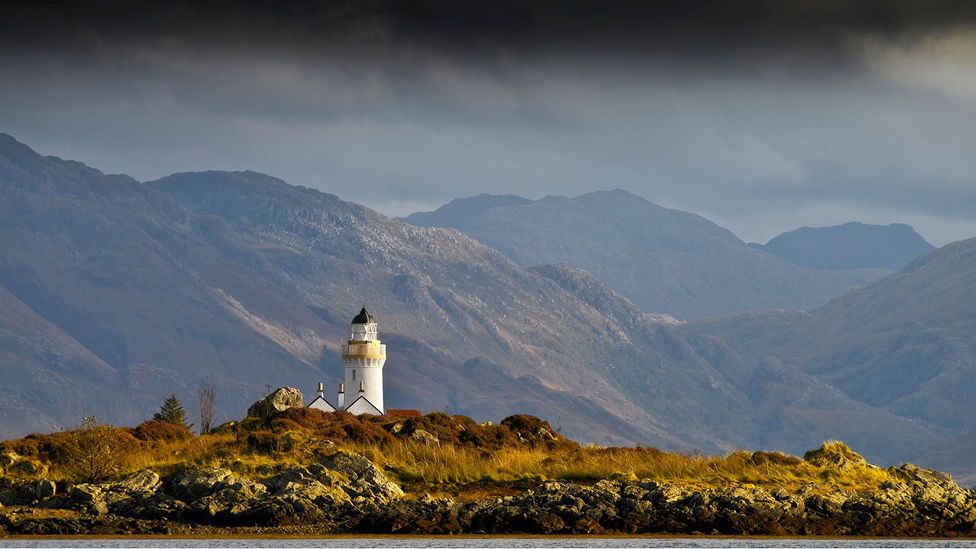
Since the 1970s, the town of Eilean Iarmain has been at the forefront of Scotland's Gaelic revival. At present, a new generation of locals are fix to share their culture with tourists.
T
The water ripples to the shoreline like a slow yawn every bit the piffling village of Eilean Iarmain on the Island of Skye gently wakes upwardly. There are deliveries for the hotel and pub, dog-walkers stop to greet friends with "Madainn mhath" (good morning) past the pier, and tourists breathe in the well-baked air and sea views earlier deciding on their day'southward adventure. The atmosphere is unhurried and inclusive, be you a local or visitor, every bit is the Gaelic style.
Since wealthy businessman and Gaelic language activist Sir Iain Noble became the landowner of a large function of Skye'due south southerly Sleat Peninsula in the 1970s, the hamlet of Eilean Iarmain has been at the forefront of a Gaelic revival in Scotland. The nearby college of Sabhal Mòr Ostaig, founded past Noble in 1973, has grown over the past 5 decades from a handful of students to become the National Centre for Gaelic Language and Culture, attracting more than 1,000 students a year.
Gaelic, which had been the main language in Scotland for centuries, began to be dismantled from the early 17th Century onwards, kickoff with The Statutes of Iona of 1609, under the reign of King James Half-dozen, which labelled it "barbaric" and called upon clan chiefs to send their heirs to English-speaking schools. Mass emigrations (some forced, some voluntary) of Gaelic speakers in the 18th and 19th Centuries didn't help, and the language was further undermined in the aftermath of the Battle of Culloden – the Jacobites' failed last stand.
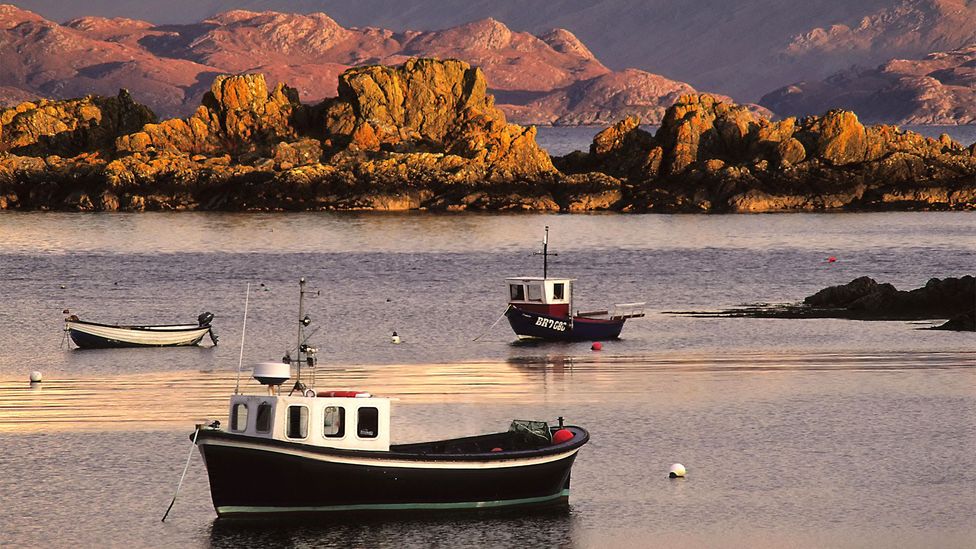
Eilean Iarmain (Gaelic for Isle Ornsay) was one time the main port on the southward of Skye (Credit: Christopher Drabble/Alamy)
Nonetheless, in rural areas, particularly in the Western Isles and other parts of the Highlands and islands, Gaelic speaking remained strong, though increasingly by the 20th Century information technology was confined to the dwelling.
Prior to Noble's arrival, a lack of jobs led young people to get out Skye and wait for opportunities elsewhere, and the Gaelic language was considered old-fashioned and at odds with this need to progress. Noble's conventionalities, however, was that the Gaelic linguistic communication could exist utilised to stem depopulation in Skye and actually get an economic commuter in its ain right.
Decades on, Noble'due south theory has slowly been proven. Sabhal Mòr Ostaig is at present one of the biggest employers on the Isle of Skye and a third of islanders speak Gaelic as either their first or 2nd language.
The college has spawned a new generation of Gaelic speakers skilled in Boob tube, business organisation and other industries that have enabled them to create more jobs on the island, only now it'south taking a more outward approach and thinking about how it can extend its Gaelic offering to visitors.
As a Londoner with Irish Gaelic heritage, I've long wanted to visit the village of Eilean Iarmain, and as expected it'southward a picturesque, though unobtrusive place. The restored Victorian whitewashed Hotel Eilean Iarmain and its adjoining pub, Am Pràban, which also forms part of the late Noble'due south holdings, dominate. If yous make it in daylight, yous'll be drawn to the h2o'southward edge to look out across the Audio of Sleat towards the hills of Knoydart. It's similar a Hollywood depiction of Scotland.
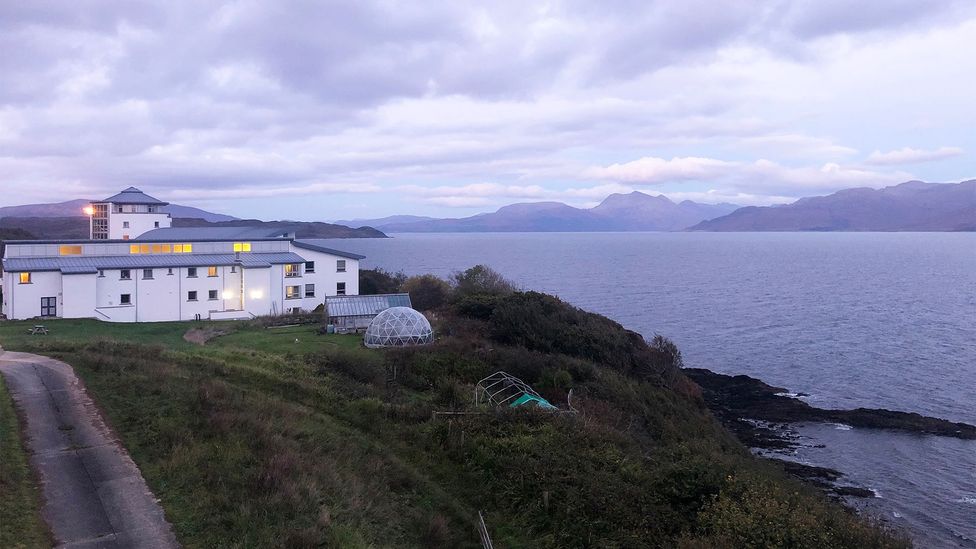
Sabhal Mòr Ostaig has become the National Centre for Gaelic Language and Culture (Credit: Emerge Coffey)
It's hard to imagine, looking at the petty pier, just Eilean Iarmain (Gaelic for Island Ornsay) was once the main port on the s of Skye. In the 19th Century, everything coming into the s of Skye came through hither, from coal to the post, fresh fish to the news. People also arrived and, more than significantly, departed from hither, whether they were heading on short trips to Portree, Mallaig or Glasgow for work or to collect provisions, or to seek new lives abroad. In 1837, the William Nicol ship left here bound for Australia with 332 emigrants onboard. According to the Sleat Local History Society, many of those on lath were forced to exit their homeland due to hardship and nutrient shortages.
Spend more than a passing hour in Eilean Iarmain – you lot can also visit a stony embankment, a knitwear shop, a Gaelic whisky and gin shop, an art gallery and a clutch of houses – and Noble's name will surely come up.
Not a native Gaelic speaker, Noble was initially met with some scepticism. Nevertheless, his love for the language shone through and today he is widely seen every bit the instigator of the resurgence of Gaelic civilization in south Skye. This resurgence was no dubiousness aided past the deep sense of belonging and so prevalent among Gaelic communities, passed downward through the generations by those who left on the ships as well as those left behind.
"Because he was looking for Gaelic speakers [to teach at the college and work in the hotel], Iain would recruit from Skye and from the Outer Hebrides and and then he would headhunt those whose families were from Skye only who, because there were no jobs, were working in Aberdeen, in London and further afield," said Lady Lucilla, Noble'due south widow. "And so, he was reversing the brain drain really."
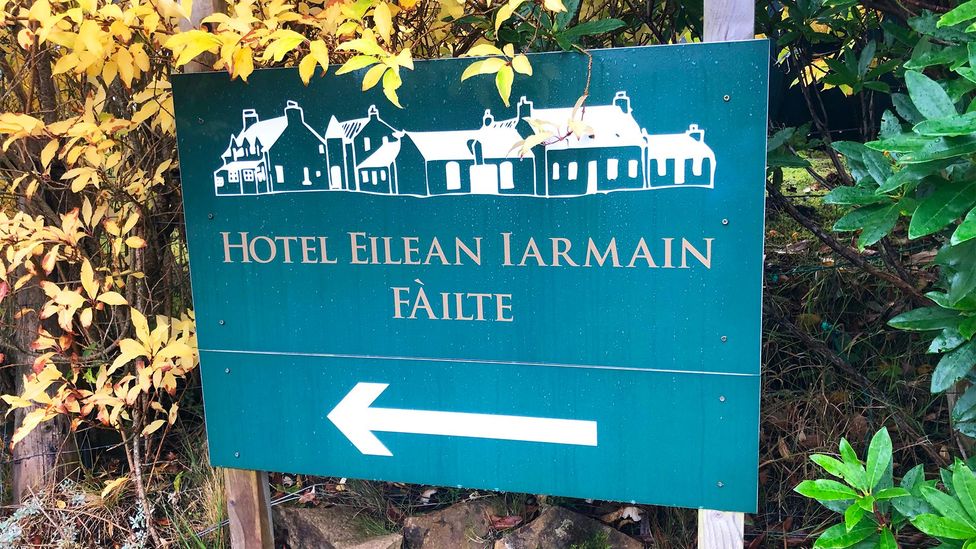
Hotel Eilean Iarmain forms part of the late Sir Iain Noble'southward holdings (Credit: Sally Coffey)
Today, Sabhal Mòr Ostaig is notwithstanding the but college in the world that delivers its learning programmes entirely in Gaelic. However, Eilean Iarmain is past no means the only part of Skye where Gaelic culture tin can be experienced: "Gaelic is potent throughout the island – and certainly in the northward of Skye, there are speakers and families that have always spoken Gaelic," Lucilla said.
Just she believes the higher and the hotel, which both provide a existent hub for the customs, were catalysts for changing perceptions of Gaelic across the island, which wasn't seen every bit very progressive, especially among immature people.
"What was astonishing about the college and the young people going there, was that Gaelic became cool," she said. "I've seen some really cool youngsters who are very proud of their Gaelic, and they're just total of the usual spirits of young people but absolutely revelling in what they have, which is a heritage going back hundreds of years."
You may also be interested in:
• Scotland's little-known 4th 'language'
• Great britain'due south most remote inhabited island
• Scotland's version of 'hygge'
One of those young people is Emily Macdonald, a 15-year-onetime musician who has grown up around Eilean Iarmain and speaks Gaelic fluently, having attended a primary schoolhouse in the Gaelic-medium.
As well as playing the bagpipes and the pianoforte and being passionate virtually Gaelic song, Macdonald regularly converses with friends in Gaelic.
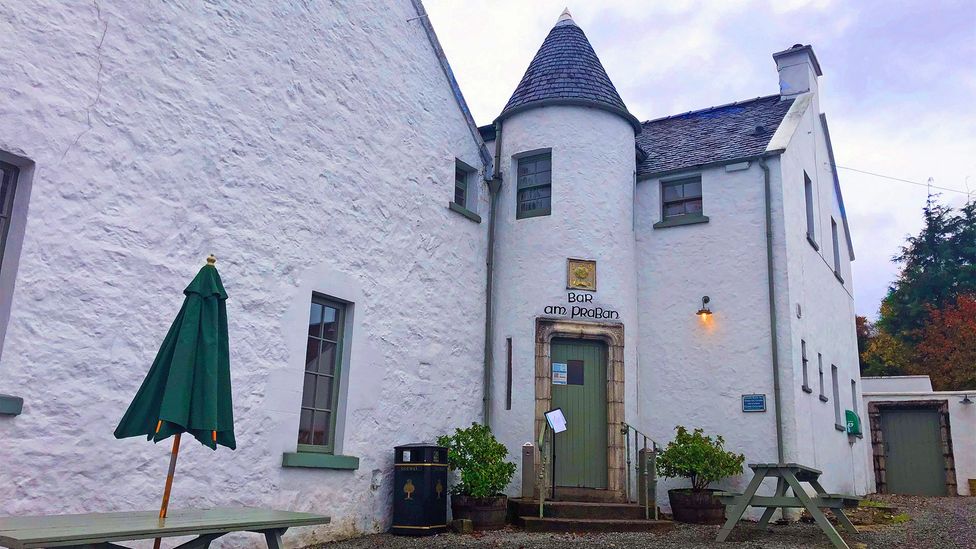
The Am Pràban adjoined to the Hotel Eilean Iarmain hosts traditional music sessions (Credit: Sally Coffey)
"At the age that we are now, I feel similar we're even more than wanting to speak Gaelic to each other, just to go on it alive, because it is really important," she said. "And to have this special language that nosotros can speak to each other in, you know, is quite special."
On my visit, I was lucky enough to meet Macdonald perform a few songs at a cèilidh (a traditional social gathering with music and dancing) in the Eilean Iarmain hotel.
Macdonald'due south singing vox is pure and melancholic, but information technology'due south the art of storytelling through song that seems to particularly drive her. "Most of the songs have been written by bards whose wives have gone away and such things, and they're singing from the place that they come from," she said. "And so, I larn quite a few songs from Skye, because I experience like the whole expanse around me comes through in the songs."
Alistair MacKay, a freelance filmmaker, studied at Sabhal Mòr Ostaig and afterwards returned to the island with his wife, Angela, to work at the college. They are now raising their 3 children on Skye.
As a pupil, he recalls many a happy dark in the Am Pràban bar, where sometimes it was so packed with revellers that yous couldn't open up the door. He also told me it was then much the place to exist that he remembers a local lad who would walk home at the end of the dark down the lonesome Ord Road, a journey of two hours or so that seems treacherous even in daytime.
How to alive the life
Take a short course
Sabhal Mòr Ostaig offers week-long Gaelic linguistic communication courses over Easter and summertime. There's also a busy plan of music, Gaelic vocal, song-writing, fine art and traditional step dance, aslope a social program of concerts, cèilidhs, lectures and dances.
Attend a festival
The Skye-based arts organisation SEALL hosts events across the isle, including the fall Festival of Small Halls and the summer Féis an Eilean.
Support local
Nearby Armadale Castle does a lot of piece of work supporting local musicians. Pre-pandemic, it likewise hosted a Gaelic Arts Week, which hopefully will make a render in 2022.
Scout a session
Few experiences can be more authentic than toe-borer or human foot-stomping along to a traditional music session in the forest-panelled Am Pràban pub adjoined to the Hotel Eilean Iarmain. Hotel Eilean Iarmain is also planning more cèilidhs and can recommend local guides.
MacKay believes the isle has so many stories that tin assist visitors connect to their surroundings and that finding a local guide who can bring the areas alive is crucial.
"Having someone there that says, 'right that mountain there is Ben na Caillich, which ways the mountain of the erstwhile lady, and legend has it she was a princess, the daughter of a Norwegian king, and she married a Mackinnon master' and so of a sudden you're like, 'correct'. Y'all've seen something in forepart of yous and now it ways something," he said. "It's connecting the country, the people, the civilization and the sense of place, rather than but driving through a landscape and thinking 'oh well, it'due south impressive but there's no context there'."
MacKay says that though Hotel Eilean Iarmain has long had a Gaelic association and has been rooted in the community, other organisations on Skye, such as Fèisean nan Gàidheal, the Aros Heart in Portree, and SEALL – which runs events such every bit Fèis an Eilein (Skye Festival), a 10-day celebration of music, literature and theatre – have besides long promoted Gaelic culture and encouraged people to irksome downwards and immerse themselves in the island's rich civilization.
MacKay isn't the merely one to see the potential of Gaelic tourism. Before this year, VisitScotland began to advise tourism businesses on how to capitalise on this aspect of their civilization.
"Gaelic and its rich culture are an of import part of Scotland'due south tourism offer and strengthens the authentic experience we know means and so much to visitors," said Rob Dickson, VisitScotland Director of Industry and Destination Development.
"Nosotros believe the language will continue to prove a valuable asset to Scotland's identity, our tourism industry and entice Scots at home to feel something new in Scotland."
Now that international travellers are finally able to return to Scotland, having a meaningful visit, particularly one that may tie-in with their own heritage, volition assist enrich their experiences.
For my part, I left Eilean Iarmain adamant to notice the time to render for a course in Gaelic song at the higher and reconnect with my own Irish Gaelic heritage. I will never be equally melodic as Macdonald, only I retrieve I may merely be able to discover some of the enjoyment in the singing that she does, and if all else fails, it will make a good story ane 24-hour interval.
---
Join more than iii one thousand thousand BBC Travel fans by liking us on Facebook , or follow u.s.a. on Twitter and Instagram .
If you liked this story, sign up for the weekly bbc.com features newsletter chosen "The Essential List". A handpicked selection of stories from BBC Future, Culture, Worklife and Travel, delivered to your inbox every Friday.
Source: https://www.bbc.com/travel/article/20211214-a-tiny-village-reviving-gaelic-culture
Post a Comment for "Again I Got Away in Gaelic"